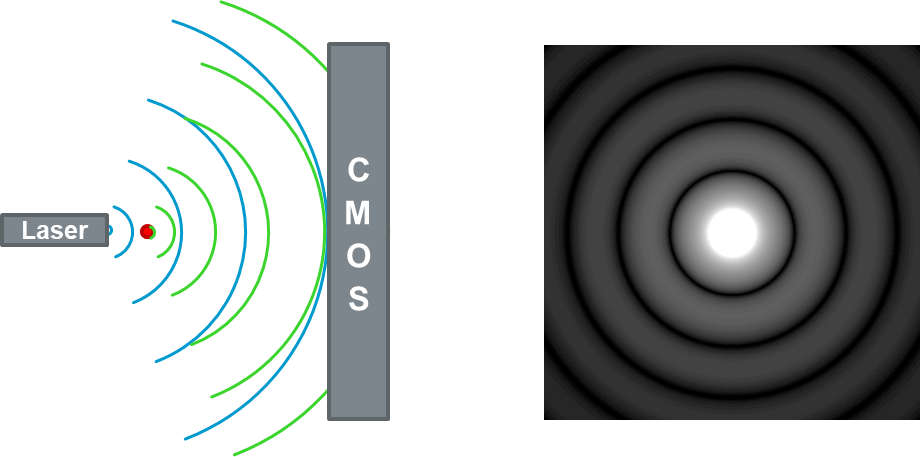Optikos touts ourselves as the Optical Engineering Experts™, so it’s always interesting when a customer approaches us to remove optics from their system! We’ve had a variety of interested parties engage Optikos about lensless imaging. This is a novel approach to imaging that removes the optical lens, while still generating high quality images using computational photography. So how does this work?
Lensless imaging seeks to collect phase and amplitude information from an object or scene, and then recreate the scene from that information. The most approachable method may be digital holographic imaging. In this scheme a coherent optical beam is reflected off of, or passes through, an object of interest. The incident beam diffracts off the object and interferes with an unperturbed beam. The combining of these two wavefronts generate a distinctive interference pattern, which is then collected by a 2D sensor such as a CMOS camera.

Alternate methods use phase masks on the camera to record phase and amplitude information from the object. There are dynamic methods as well with modulating sources or phase masks.
In all cases, the amplitude information on the sensor, combined with measured or inferred phase information, knowledge about the light source and physical position of the various components, and a capable processor, allows the object to be computationally generated.
What Are the Market Applications?
There is interest for low resolution applications where very small and thin sensors may be beneficial (e.g. wearable cameras used for sensing hand gestures, people, etc). The lack of a lens means the camera can be almost impossibly thin. And the cost of a lens is removed, however this runs into challenges with image frame-rate and real-time viewing (more on this later).
Another highly researched application is microscopy. The large physical size of CMOS sensors may allow lensless imaging to achieve very large fields of view (FOVs), while maintaining very good resolution. And there is novel information you can gain from the scene. For example, when imaging a semi-transparent object like a blood cell, the illumination light passes through the object and collects phase information. That allows the computationally generated image to “see” features inside the cell which may support cell identification. Traditionally this would require staining the cell or more advanced microscopy methods.
The hope is that lensless imaging enables low cost ‘lab on chip’ measurement platforms. For these microscopic imaging applications, one typically benefits from sparsely populated scenes, ideally in a monolayer.
An added benefit for any application, you can refocus on the fly with just an algorithm tweak. No mechanics and no motion control!
What are the downsides?
The biggest issue is probably the newness of this technology and its readiness for product implementation. There are significant technical challenges and risks that need to be addressed – some of the downsides are:
- Poor image quality and high error rates – this is usually due to computational challenges, which can include sensor noise, reconstruction noise, errors due to light source and sample variability, coherence effects off of sample features (channels or walls) or other internal components. All these can make an accurate reconstruction difficult.
- Non-real-time imaging – the computational load makes real-time imaging impractical, the reconstruction is usually an iterative post-processing operation.
- Monochromatic imaging – commonly a laser or LED illumination source is used, and the light source may be expensive and/or require some stabilization.
Is it really cheaper?
We often hear excitement about the potential cost reductions that lensless imaging can yield. The stated reason is that optics are the most expensive part of an imaging system. That may or may not be true, but there are two important and overlooked points:
- A custom lens, designed specific to your application, can often be dramatically cheaper than an off-the-shelf solution. Optikos developed and currently manufactures a microscope capable of high-quality cell imaging for a few hundred dollars in quantities of <500 pcs. This includes the lens, light source, focus stages, and sensor. This is cheaper than a brand-name microscope objective (and that’s not counting camera, stages, tube lens, etc).
- For lensless imaging, processing power is often omitted from the cost discussion, but should be included – lensless imaging requires a significant computational capability, increased electrical requirements, heat generation, and associated costs. Comparing lens to no-lens is an incomplete comparison.
Optikos is probably a little biased, but we don’t expect traditional lenses to disappear anytime soon. That said, over 40+ years we’ve seen countless novel technologies successfully transition to mass market applications. There are specialized applications today that may be a good fit for this technology, and as computational power continues to increase we may see lensless imaging become a more broadly deployable solution.
In the meantime, we’re excited for those researchers who are pushing this science forward! As the technology matures we will certainly include lensless imaging as a possible architecture for new product development.

